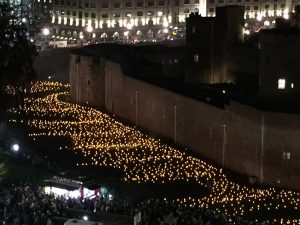 “They do not know that in this shadowed place It is your light they see upon my face” ~ Mary Borden
“They do not know that in this shadowed place It is your light they see upon my face” ~ Mary Borden
There was no forward planning whatsoever, but by pure fluke we ended up in the UK for the centenary celebrations of the end of the Great War. Although the last living veteran of World War I died in 2012, aged 110, this rather special Remembrance Day has obviously hit a chord here in England.
On Saturday night, on BBC One, we watched the Royal British Legion host the Festival of Remembrance at the Royal Albert Hall, attended by most of the senior members of the Royal Family. This is an annual event that has been held at the Albert Hall since 1923 to commemorate the British and Commonwealth servicemen and women who lost their lives in the two World Wars and today, subsequent conflicts as well. Full of pomp and circumstance, marching and music, there were many spine tingling moments, not least when the ceiling rained with red poppies upon the heads of the silent servicemen and women during the two minutes silence. And despite the recent Royal fervour, following two royal weddings and royal babies, it was a sign of the solemnity and importance of the occasion that for once the cameras were not fixed on the Duchesses of Cambridge and Sussex, but on those soldiers performing in the centre of the hall.
We also joined in to two minutes silence on Sunday morning, when we walked down to the village green, to observe the Remembrance Day service in front of the village church. The local scout troops, church officials and the choir paraded around the village pond, before gathering around the cenotaph. It is a moving, albeit a slightly unnerving experience, to stand in complete silence for two minutes among a large crowd of strangers of all ages, from the elderly in wheelchairs to the small children in their prams, and everyone in between. The rain fell lightly throughout the service, but as it came to an end, the rained stopped and the sun came out as if specially choreographed.
Later, we caught the train to London, to stay near the Tower of London. From the seventh floor of the CitizenM hotel at Tower Hill, we were able to watch the fabulous light and sound installation, “Beyond the Deepening Shadow: The Tower Remembers,” created as an act of remembrance for those that died in the Great War.
As the sun set over the Thames, on this chilly but clear Sunday evening in late autumn, the crowds gathered around the outer walls of the Tower and the moat filled with smoke, resembling the trenches of the Somme submerged in canon smoke. Then, a procession of Yeoman Warders of the Tower of London entered the moat to light the first flame. The subsequent lighting of thousands of flares was accompanied by the music of Mira Calix, a piece commissioned by the historic royal palaces. This choral piece is described as ‘a sonic exploration of the shifting tide of political alliances, of unity and division, of love and loss in war. Calix used lyrics taken from “Sonnets to a Soldier iii” by suffragette and war poet Mary Borden, and performed by Solomon’s Knot and Laura Cannell. How the flares were lit so quickly is beyond me, but in a very short time, the moat was lit up by the glow of thousands of small flames
the outer walls of the Tower and the moat filled with smoke, resembling the trenches of the Somme submerged in canon smoke. Then, a procession of Yeoman Warders of the Tower of London entered the moat to light the first flame. The subsequent lighting of thousands of flares was accompanied by the music of Mira Calix, a piece commissioned by the historic royal palaces. This choral piece is described as ‘a sonic exploration of the shifting tide of political alliances, of unity and division, of love and loss in war. Calix used lyrics taken from “Sonnets to a Soldier iii” by suffragette and war poet Mary Borden, and performed by Solomon’s Knot and Laura Cannell. How the flares were lit so quickly is beyond me, but in a very short time, the moat was lit up by the glow of thousands of small flames
(Coincidentally, I have been reading a book about the women who influenced the life and reign of Elizabeth I, and it seems ironic to be watching a display that celebrates those that died for their country on a spot infamously renowned for the beheading of traitors in previous centuries.)
From country churches to city cathedrals, poppies have been thick on the ground. You may remember the ceramic poppies that were made to fill the moat at the Tower of London four years ago, to commemorate the 100th anniversary of the beginning of the Great War. This year, every country church we passed was bedecked in knitted woollen poppies. They may not survive a heavy deluge of winter rain, but for now they are a bright, international symbol of remembrance in an otherwise grey world.
* With thanks to Google Images for the amazing knitted poppies, and the One & Only for the glorious view of the Tower on Armistice Day.
